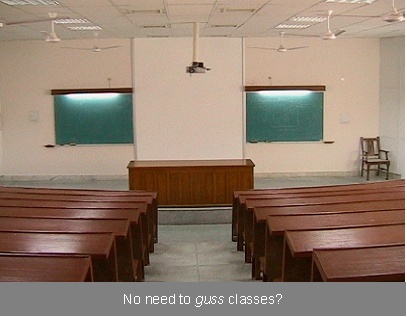| |
Evaluation pattern at BITS – a new story
By Hemabindu Chitta ('02 Chemical)
Six courses, with two tutorials and three lectures a week in each, halfway through the semester, three days of gruelling mid-semester examinations, two each day, then more tuts and finally the compres. No, this is not the schedule of a EEE CDC-ite but that of the hapless BITSian first year student. Along with the distinction of being the first batch of students to have come through the BITSAT, the newcomers are also the first people on whom a massive experiment in evaluation methods is being unleashed.
Why the change?
The administration's take on this is, predictably, more holistic. We learnt from the VC, Dr. S. Venkateswaran, that a change in teaching methods had been on the cards for a long time now. "That was the idea behind building the Lecture Theatre Complex," he revealed, explaining that the new system is modelled on that of IIT system of evaluation. Students now have a limited number of large
lecture sections, where experienced professors stress on conceptual learning. The tutorial sessions are intended to encourage application of these concepts, and build problem-solving skills. It is felt that such a dual emphasis would make the student truly competent in a subject.
This explains why a single professor handles Chemistry I for the entire first year batch, while new faculty members take on the tutorial sessions in smaller, more interactive sessions. Those familiar with the structure of EEE CDC courses will remember that certain courses like Digital Electronics have always been structured this way. Two professors take the lecture sessions while the weekly tutorials see new lecturers and TAs in action. Most significant, perhaps, is the fact that the new lecture-tutorial system of teaching has been extended, in one form or another, to several second year courses and all CDCs except those of Computer Science and Information Systems (these disciplines have heavy course weightage for online assignments, which cannot be effectively substituted with tutorials).
Why are students complaining?
The condemners of the previous system believe that the idea of regular tutorials forces students to remain up-to-date with what is being taught, which is definitely a good thing. In stark contrast, the entrenched BITSian tradition is to study the night before a test, and to count on the next test to go well if you fail to perform well in one. Fourth and fifth yearites on campus c the get an be heard reminiscing about the "good old days" when classes could be bunked en masse and BOSM was not spent in the shadow of the approaching midsems.
So BITSians are learning more than they ever have. How can that be a bad thing? Well, for starters, the total number of hours spent in class has gone up to 32 per week per first year student. There are twelve tutorials per week - so many, in short, that they are no longer taken seriously, or prepared for. And if one does badly in the mid-sem, there is no hope of redemption. It's a win-all, lose-all situation.
Though no one in the administration will openly admit it, observers suspect that the real reason for the
change in teaching and evaluation was the desire to
improve attendance. The higher-ups had hoped that the new system would phase out
students absconding from classes and appearing before the familiar BITSian saga of
classes and appearing before professors merely to write tests and collect papers. Sadly, however, nothing of the sort seems to have been accomplished. Classes remain steadfastly empty, and students have taken to attending only the tutorial components.
Another theory circulated in secret is that the administration wanted less emphasis on extra-curricular activities in BITS. The first yearites, burdened with the additional workload, can now hardly sp end time getting to know seniors and batchmates in clubs and departments. The mid sems happen barely ten days before Oasis, which is
the focal point of BITSian social and cultural life. Work
for Oasis usually gathers steam just about a fortnight
prior to the fest, and it is very unlikely that the timing of the mid sems is a coincidence.

NO extra-curriculars?
The jury is still out on the new system, and whether or not it will continue to hold sway in semesters to come. As for the regular tutorials, no one says they are a bad idea. But reducing the number per week might make students take the components more seriously. It would also reduce the pressing demands on their time, and allow them to relax and engage in activities that aid their all-round development. After all, BITS has always prided itself on producing students who can, at the end of four years, be good at anything they choose to take on. A uni-dimensional education is certainly not conducive. A careful and critical assessment of the new system is in order, and incorporating this system's benefits into a newer, more balanced model would be a healthier change.
¨
|

